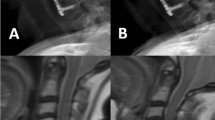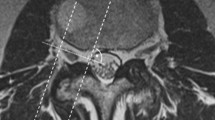Abstract
Purpose
To evaluate the utility of magnetic resonance three-dimensional fast-imaging employing a steady-state acquisition (MR 3D-FIESTA) sequence to study cervical EFLs using the anatomical results of cadavers as the gold standard.
Methods
Part I: The cervical regions of five embalmed adult cadavers were scanned using the MR 3D-FIESTA sequence. Ligamentous structures in the intervertebral foramina (IVFs) between C4 and T1 in the MRI scans were identified by a radiologist. Part II: After the specimens were scanned, gross and microscopic anatomical studies were conducted on the IVFs between C4 and T1 in the specimens by an anatomist. Part III: Using the anatomical results of the cadavers as the gold standard, the utility of the MR 3D-FIESTA sequence for imaging cervical EFLs was evaluated. Specificity, sensitivity, positive and negative predictive values (PPV and NPV, respectively) and accuracy were calculated.
Results
The occurrence rate of transforaminal ligaments (TFLs) in the IVFs between C4 and T1 was 42.5%. The results obtained by the radiologist using the MR 3D-FIESTA sequence to identify TFLs are as follows: specificity 96.2%, sensitivity 76.5%, PPV 92.9%, NPV 86.2%, and accuracy 88.4%.
Conclusion
MR 3D-FIESTA sequences clearly showed cervical EFLs. In the 3D-FIESTA sequence scans that the radiologist believed to indicate the presence of a cervical TFL, the probability that the TFL existed was approximately 93%. When the radiologist believed that no TFL was present in the 3D-FIESTA sequence scan, the probability that a TFL existed was 14%.




Similar content being viewed by others
References
Kraan GA, Smit TH, Hoogland PV et al (2010) Lumbar extraforaminal ligaments act as a traction relief and prevent spinal nerve compression. Clin Biomech (Bristol, Avon) 25(1):10–15
Amonoo-Kuofi HS, El-Badawi MG, Fatani JA (1988) Ligaments associated with lumbar intervertebral foramina. 1. L1 to L4. J Anat 156:177–183
Bakkum BW, Mestan M (1994) The effects of transforaminal ligaments on the sizes of T11 to L5 human intervertebral foramina. J Manipulative Physiol Ther 17(8):517–522
Amonoo-Kuofi HS, El-Badawi MG, Fatani JA et al (1988) Ligaments associated with lumbar intervertebral foramina. 2. The fifth lumbar level. J Anat 159:1–10
Cramer GD, Skogsbergh DR, Bakkum BW et al (2002) Evaluation of transforaminal ligaments by magnetic resonance imaging. J Manipulative Physiol Ther 25(4):199–208
Min JH, Kang SH, Lee JB et al (2005) Anatomic analysis of the transforaminal ligament in the lumbar intervertebral foramen. Neurosurgery 57(1 Suppl):37–41
Kraan GA, Hoogland PV, Wuisman PI (2009) Extraforaminal ligament attachments of the thoracic spinal nerves in humans. Eur Spine J 18(4):490–498
Shi B, Zheng X, Zhang H et al (2015) The morphology and clinical significance of the extraforaminal ligaments at the cervical level. Spine (Phila Pa 1976) 40(1):E9–E17
Lohman CM, Gilbert KK, Sobczak S et al (2015) 2015 Young Investigator Award Winner: cervical nerve root displacement and strain during upper limb neural tension testing: Part 2: role of foraminal ligaments in the cervical spine. Spine (Phila Pa 1976) 40(11):801–808
Takashima H, Takebayashi T, Shishido H et al (2016) Comparison with magnetic resonance three-dimensional sequence for lumbar nerve root with intervertebral foramen. Asian Spine J 10(1):59–64
Qian Y, Qin A, Zheng MH (2011) Transforaminal ligament may play a role in lumbar nerve root compression of foraminal stenosis. Med Hypotheses 77(6):1148–1149
Transfeldt EE, Robertson D, Bradford DS (1993) Ligaments of the lumbosacral spine and their role in possible extraforaminal spinal nerve entrapment and tethering. J Spinal Disord 6(6):507–512
Olsewski JM, Simmons EH, Kallen FC et al (1991) Evidence from cadavers suggestive of entrapment of fifth lumbar spinal nerves by lumbosacral ligaments. Spine (Phila Pa 1976) 16(3):336–347
Caglar YY, Dolgun H, Ugur HC et al (2004) A ligament in the lumbar foramina: inverted Y ligament: an anatomic report. Spine (Phila Pa 1976) 29(14):1504–1507
Author information
Authors and Affiliations
Corresponding authors
Ethics declarations
The experiments comply with the current laws of China in which they were performed.
Conflict of interest
The authors declare that we have no conflict of interest about the article.
Additional information
J. Li and B. Shi equally contributed to this work and should be considered as co-first authors.
Rights and permissions
About this article
Cite this article
Li, J., Shi, B., Qiu, S. et al. A controlled study on the anatomy of cervical extraforaminal ligaments and three-dimensional fast-imaging employing a steady-state acquisition sequence. Eur Spine J 26, 1039–1046 (2017). https://doi.org/10.1007/s00586-016-4823-7
Received:
Revised:
Accepted:
Published:
Issue Date:
DOI: https://doi.org/10.1007/s00586-016-4823-7




